During the trip, our daily updates focused on the food we created during our week- long stay on La Isla Encanta. A CulinaryCorps trip, however, is a two-way street Ray Ban outlet allowing our volunteer chefs to share their food with the community, and the community to share their food with us. Weaved in throughout the week are opportunities to immerse ourselves in the cuisine of the people we have come to assist, and in doing so, understand a major source of history, identity and pride. Puerto Rico proved to be a wonderful culinary adventure all week, and we wanted to capture some of our experiences in this journal.
Descriptions and pictures after the jump:
A CHRISTMAS DINNER IN CAYEY
The day we all first meet as a team is often one wracked with nerves. Each of us has those butterfly feelings that harken back to the “first day of school” jitters . Will people like me? Will I like the group? Am I a good enough cook to be part of this trip? Am I ready for this challenge?
Over the years, we have found the best way to move past these unfounded hesitations is by sitting down to a meal together. This trip’s first meal happened to be Occhiali Da sole Ray Ban outlet filled with a lot of pork, a surefire way to cut the tension in a roomful of cooks. The evening started with a trip up the tropical mountains of interior Puerto Rico, about a half-hour south of San Juan, to the town of Guavate. Also known as the “roast pig route” Guavate is a pork lover’s paradise with roadside restaurants of whole-roasted pigs lining the streets like street lights.
Walking into one of these joints feels like you’ve arrived in porcine heaven. There are steaming hot trays filled with every cut of succulent roasted pork (from loin to tail) all clinging to crispy bits of caramel-colored skin. Plus, large quantities of sausages in every shape, size and color, rice, beans and plenty of hot sauce. We bought about 8 pounds of roasted meat, chopped via machete in front of the crowd, for our dinner later that evening.
While some could not tear themselves away from the rotisserie, a few of us explored the small stands by the underpass run by local entrepreneurs selling artisan food products. There was local honey, coconut and orange candy and a unique fermented drink called mavi. Made from the bark of an indigenous tree, the beautiful pink liquid is reminiscent of a very sweet Kombucha.
Our climb into the mountains http://www.raybanoutletes.com/ continued, and we finally reached the beautiful estate in Cayey that was our destination for the evening. Our co-leader, Viviana, had graciously invited us into her family’s home to share in a traditional Christmas meal. The platters of pastelillos (crescent-shaped fried turnovers filled with meat and guava paste respectively) and sausages (both morcilla and a smoked variety that contained hunks of pork and cilantro) first graced the table. We dug right in.
After a taste of the local moonshine or Pitorro (a flavorless rum that was then steeped in prunes and spices for several months) as well as a few cans of Medelia (the ubiquitous beer of the island) we sat down to a richly nuanced Puerto Rican feast. We tucked into our roasted pork, Spanish rice with pigeon peas, banana-leaf wrapped lllame pastelles (sweet potato-like dumpling), fricase of chicken with olives, and fresh-from-the-oil tostones (fried, green plaintains).
We also talked about the unique sticky “savoriness” of Puerto Rican rice, and the foundation of all good Puerto Rican cuisine, sofrito. Most home cooks make their own version from sweet peppers, garlic, onion, herbs and oil but the refrigerated section of any local supermarket will yield dozens of pre-made sofritos of varying degrees of quality.
For dessert, we were pulled generous shots of strong Puerto Rican coffee by our host, which proved to be a bitter antidote to the sweet and rich coconut tembleque, a wobbly flan-like dessert that “trembles” when you eat it. Over steaming cups of coffee, the merits of the traditional calderos were discussed, the aluminum cooking pots that get all the credit for the perfect rice all Puerto Ricans seem to be gifted at making.
A TRIP TO THE MARKET WITH A TROPICAL NATURALIST
On one of the first evenings of our trip, we met up with Chef Rebecca of Afrodita catering at the Santurce market. A Puerto Rico Slow Food member, chef-instructor and island caterer, Chef Rebecca specializes in vegetarian Puerto Rican cuisine. Without meat, she uses the wonderful array of indigenous Puerto Rican produce and products to create dishes that taste wonderful and boast medicinal properties as well.
Our tour of the market started with a description of the incredible variety of root vegetables Puerto Ricans use in their cooking. For those of us who are most familiar with potatoes and their kin, these hairy, gnarly, tubular (and often huge) specimens were a sight to behold. We were shown two different types of taro, batata, llame, yautia and cassava, and quickly explained the nutritive properties of each. Many of us also took a keen interest in the hanging bunches of plaintains in varying stages of ripeness. Chef Rebecca explained that the green, hard plaintains Gafas Ray Ban outlet are eaten in a savory manner, used for frying (especially in mofongo) or in stews and plaintain balls. The yellow or black plaintains are a popular breakfast food when baked and sprinkled with sugar. Interestingly, she recommended that green plaintains be eaten before the sun sets as they are slightly harder to digest, and will not sit well in your stomach while sleeping. We also took a closer look at papaya, noting that the peppery seeds are great for cleansing the body. Finally, we left with a giant hunk of Puerto Rican pumpkin, or calabaza.
After our market rounds, we made our way back to Chef Rebecca’s cooking studio for a hands-on cooking class. First, she showed us some staples of Puerto Rican cuisine including annatto seed as well as a few plants she finds to be underutilized in the country including the wispy, outer husk of the coconut (great to use as a strainer instead of cheesecloth) and lemongrass, almost a weed on the island and a lovely tea when steeped with ginger in hot water.
With a little help from the group, Chef Rebecca made a wonderful rendition of the classic tuber stew, sancocho. Typically made with meat, this vegetarian version combined root vegetables, plaintain dumplings and lentils,and made up in richness what it lacked in meatiness. For the only time on the trip, we were served brown rice to go with our meal – a reminder on how sacred white rice is to this culture – as well as baked batatas. And to round out the meal, we enjoyed mojito (a traditional garlic dipping sauce) on the cracker-like cassava bread, a traditional food introduced to the island by the native Taino population.
A TASTE OF PUERTO RICO’S CULINARY INFLUENCES
Puerto Rico prides itself on being a melting pot of cultures. Dance, art, architecture have all be uniquely altered by the blending of centuries of immigrants. Food is no exception.
Throughout our trip, we were reminded of many influences the Spanish left behind. From the language to the wrought-iron work in Old San Juan, Spanish cuisine has also played a large role in shaping the way the country eats. Some of San Juan’s most beloved “diners” are Spanish, and we were lucky enough to be staying right around the corner from one of the best, Kasalta. When mornings would allow, many of us took in our first meal of the day here enjoying jamon y queso on a mallorca (soft roll) sprinkled with powdered sugar and dense tortilla Espaniola studded with potatoes.
We also enjoyed a modern take on the traditional Spanish meal at Cien Vinos, a wine store specializing in tapas in the Guaynabo section of San Juan. We were treated to small bites including stuffed rice balls, salmon rilletes and white bean spread on toast then plates of seafood rich paella and finally, sweet mounds of creatively flavored flan, including one that used the most famous of Spanish cheese, Manchego. Our lovely host, Franco, narrated the wine selection for the evening, a combination of wines from across all regions of Spain.
We also indulged in Argentine pizza (a favorite among the locals; both crispy and chewy owing to a large quantity of oil in the dough), and witnessed the many Dominican Republic influences on the cuisine, especially in the roadside stands of Pinones.
THE FLAVORS OF LOIZA
A visit to the small northeastern town of Loiza is like a walk back in time. First settled by escaped and freed slaves from Nigeria, it has remained isolated both by its cultural proclivities and geographic positioning, flanked by two rivers and the ocean. A tight-knit community, Loiza works hard to preserve its traditions including an emphasis on music and dance as well as food and art. However, it is also an economically depressed community that looks upon tourist dollars as it only salvation. A visit to Loiza now will help to save this incredibly special community.
Our first stop for the day was the Loiza Cultural Center, where we were immediately met with the deep, rhythmic sounds of the bomba and plena.
A percussion-driven musical tradition, the bomba is a pact between the dancer and the drummer. Unchoreographed, the dancer “leads” the drums to change beats and rhythms according to their movements. Once settled into the performance, the drummer can then play with the dancer trying to control his/her steps. Rooted in dance customs brought to Puerto Rico from Africa, the bomba is truly a wonder to watch, and after being taught a few steps by our host, a joy to take part in. Later on in the day, we were also able to take in a performance of the Ayala family, one of two of Puerto Rico’s most prominent musical families in the tradition and world ambassadors for the music and dance of Loiza.
Next it was off to visit the cathedral of St. Patrick in the center of town, a perfect example of the seamless blending of cultures in Loiza. It was St. Patrick that was credited to ending a plague of ants that was ruining the local food supply, thus, their homage to him in this gold-plated altar.
A quick side trip also took us to a local geological curiosity, Cueva de Maria, a cave where Tainos allegedly lived before the arrival of Christopher Columbus, and the home to a happy hermit for many years. It is now host to enormous hanging hives of honeybees.
Returning back to the cultural center, we sat down to learn about the history of caldo santo (Loiza’s town dish) from the woman keeping the tradition alive, Carmen L. Rivera Rodríguez, lovingly referred to as Dona Yiya. A hearty stew, caldo santo is one of the few examples of Puerto Rican cooking that uses coconut milk in a savory capacity.
Incorporating fish (in ours, kingfish) as well as tubers, caldo santo loosely translates to the “medicinal soup of saints” and is eaten during their yearly celebration, Fiestas Tradicionales de Santiago Apóstol. The festival also makes good use of the discarded coconut shells, turning them into elaborately decorated masks.
Our next course was enjoyed at El Buren de Lula, owned and operated by María Dolores de Jesús (Sector El Jobos Tel. 787-876-1095). Dona Lula cooks over an open flame on a buren, the traditional flat metal cook top once a mainstay in every Loiza home.
She makes everything herself, by hand, from local ingredients just as she has been doing for decades. People come from all over to sample her land crab with rice, stewed red beans with pig’s feet, and crabmeat cassava empanadas cooked in banana leaves. Her kitchen was as full of character as her food, and she is a living museum to a foodway that is slowly disappearing. In anticipation of our next stop, we picked up some sweet empanadas seasoned with cinnamon, a gift for the artist Samuel Lind, who was welcoming us to his home.
When you first enter the house of Samuel Lind, you feel as if you immediately understand the vibrancy of the community that fuels his work. His imagery and colors depict Loiza in its raw, round and often emotional, state. Working as a sculptor, a painter and a lithograph artist, Samuel uses his birthplace as inspiration…the vejigantes (colorfully dressed evil spirits) of the festival, the bomba dancers in their sweeping, pure white, costumes, the wildly green mangroves and of course, the food. We took a glimpse into his childhood kitchen in one of his prints, and saw women at the buren in many others, women just like Dona Lula. Because we were all cooks, he wanted us to see his own kitchen. There hung a captivating portrait of mother earth, rotund, commanding and compassionate. His display of this piece in his kitchen made us all realize just how much faith and honor he placed in food.
When we finally headed back to the vans, the beat of the bomba reverberating through our limbs, we were all in a magical trance. There are not many times in your traveling life when a community feels so real, so rich, and so endearing. We are forever indebted to Loiza for its hospitality, and its willingness to showcase its intimate culture to us strangers. It was as delicious as it was inspirational. Thank you.
OUR CONTRIBUTION
While we were traveling, we made sure that we showed our appreciation to our project partners and hosts in the form of a small departing gift. We were thrilled to get a donation of FEED 100 bags from Whole Foods Market Bowery to give out along with bacon chocolate bars by Vosges. Every FEED bag helps to provide 100 school lunches to children living in Africa through the World Food Program.
In addition, our chef-volunteers were given a copy of the new cookbook, The Dumpling: A Seasonal Guide by Wai Chu and Connie Lovatt. A seminal guide to the wonderful world of dumplings, this book also highlights two traditional Puerto Rican recipes including wrapped cassava “tamales” stuffed with chickpeas and pork) and plantain dumplings in chicken broth. A wonderful reminder of just a few of the many incredible dishes we learned throughout the week.

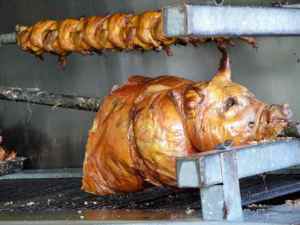
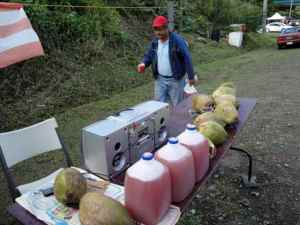

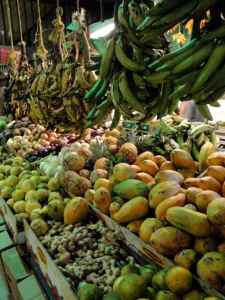






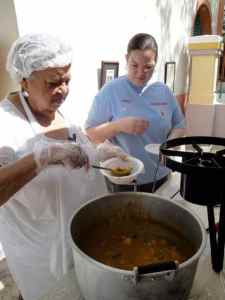
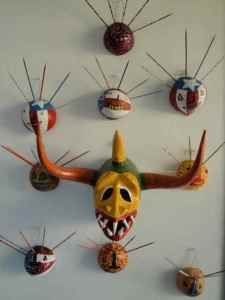

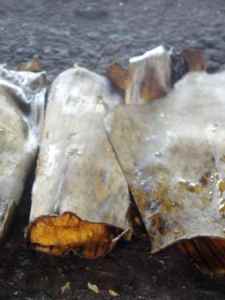



What an inspiring awesome trip! Posts made me feel like I was there cooking along with you…a joy to read, an adventure to remember.
Me gusta
que chvere 🙂